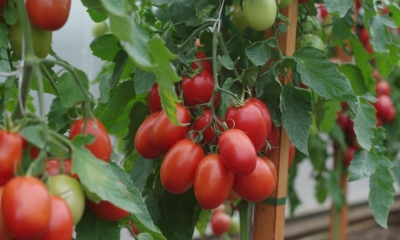
- Authors: Blokin-Mechtalin V.I.
- Year of approval: 2021
- Category: hybrid
- Growth type: determinant
- Appointment: fresh consumption
- Ripening period: early
- Ripening time, days: 95-100
- Growing conditions: for open ground, for film greenhouses
- Transportability: Yes
- Bush size: undersized
The catchy and expressive name of a number of varieties of garden crops immediately attracts attention. But it is important to understand what is hidden behind such big names. It is worth familiarizing yourself with the Vesuvius tomato.
Breeding history
This is a completely new culture. Official admission for growing in practice was given to her only in 2021. The author of the development is the already well-known breeder Blokin-Mechtalin.
Description of the variety
Vesuvius cannot boast of high growth - its bushes rise only up to 1 m. The plant is of a determinant type, it is formed relatively compactly. Average foliage is typical for it. The foliage, like most tomatoes, is of medium length. It is painted in a simple green color.
The main qualities of the fruit
When the berry is just forming, it has the same green color. There will be no spots in the area of the stalk. When ripening, the fruits turn red. The mass of a single tomato does not exceed an average of 100 g, its size is relatively small. The shape is like an inverted egg with a reverse tilt.
Other important nuances:
thick and smooth, high density rind;
formation on intermediate inflorescences;
articulated stalk type;
a decent level of keeping quality.
Taste characteristics
Tasters note the sweetness of Vesuvius berries. It is still impossible to characterize more precisely because of the extremely small experience of using culture.
Ripening and fruiting
Vesuvius is one of the earliest tomatoes. It can yield a harvest in 95-100 days after discarding green shoots. Importantly, the brushes ripen together. This is great for most gardeners because it allows for crisp schedules.
Yield
The collection can reach 13.5-14.5 kg per 1 m2. Of course, for such a success, you need to make some effort. However, compared to other varieties, Vesuvius is quite attractive.
The timing of planting seedlings and planting in the ground
Thoroughly developed seedlings should be moved to open ground in the first weeks of the calendar summer. It is worth focusing on the actual weather and the degree of warming up of the earth. It is optimal to plant seeds in containers during March. Then it will be possible to ensure full readiness for the summer period.

Growing tomato seedlings is an extremely important process, because it largely depends on whether the gardener will be able to harvest at all. All aspects must be taken into account, from seedbed preparation to planting in the ground.
Landing scheme
There are 3 or 4 plants per 1 m2. It is better to plant fewer bushes, but take care of them more carefully. Then the tomato will definitely reward the farmers for their efforts and arrange a real "eruption" of fruits.

Growing and care
It is necessary to form this plant in any case. Usually forming in 3 stems, but sometimes a 2-stem technique is recommended. Vesuvius needs lighting for 12 hours. If the sun does not give the desired effect, its deficiency is compensated for with the help of special lamps. It is better not to water the seedlings, but to spray them with a spray bottle.
A pick is made when the 2nd true sheet appears. Vesuvius needs to be grown-up every 10 days. High trellises are used for the garter. Fruiting brushes are recommended to be additionally strengthened. Top dressing is used:
during flowering;
when laying the ovaries;
when the fruits are ripe.




A plant needs different micronutrients at each stage of growth. All fertilizers can be divided into two groups: mineral and organic. Folk remedies are often used: iodine, yeast, bird droppings, eggshells.
It is important to observe the rate and period of feeding. This also applies to folk remedies and organic fertilizers.
Disease and pest resistance
The variety tolerates contacts with pathogens:
cladosporiosis;
fusarium wilting;
tobacco mosaic.
At the same time, they are almost not dangerous for him:
anthracnose;
invasion of nematodes;
spotting (although it is still necessary to take special measures).


Growing regions
The possibility of cultivation is declared in:
Central Black Earth Region;
regions of the north and northwest of the Russian Federation;
territories and republics of the North Caucasus;
Middle and Lower Volga region;
Kurgan, Sverdlovsk, Chelyabinsk regions and other areas of the Urals;
practically in all territories of Siberia and the Far East (with the exception of the regions of the Far North and equivalent areas).
Review overview
Fertility is quite high. The variety is suitable for canning and shaping homemade products. The plant can perfectly transfer transplanting from seedling containers to open ground. Naturally, this requires compliance with strict agricultural standards.The thick rind poses problems when eaten fresh or whole fruit canned.

























































































